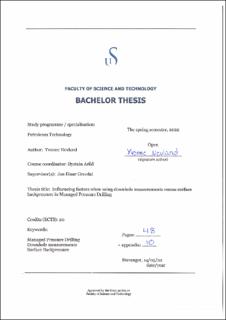| dc.contributor.advisor | Gravdal, Jan Einar. | |
| dc.contributor.author | Yvonne, Nevland. | |
| dc.date.accessioned | 2022-07-15T15:52:45Z | |
| dc.date.available | 2022-07-15T15:52:45Z | |
| dc.date.issued | 2022 | |
| dc.identifier | no.uis:inspera:108212691:50845381 | |
| dc.identifier.uri | https://hdl.handle.net/11250/3005871 | |
| dc.description.abstract | I fremtiden vil olje- og gasselskaper utføre flere boreoperasjoner i krevende miljøer som dypt vann, uttømte reservoarer, brønner med utvidet rekkevidde og høytrykksbrønner med høy temperatur. Disse boreoperasjonene krever høy nøyaktighet og forsiktighet fordi de har et smalt trykkvindu. Disse brønnene er mer utsatt for tapt sirkulasjon, formasjonstilstrømning og pakking. Som et resultat vil ikke-produktiv tid øke samtidig som det skaper en farlig situasjon for plattformen og folk, hvis hendelsene ikke håndteres riktig.
Tradisjonell dataoverføring fra nede i hullet under boring har lav båndbredde og høy tidsforsinkelse, noe som gjør bruk av sanntidsdata upraktisk. Som et resultat bestemmes tilstanden til brønnen for det meste av overflatemålinger og borerens kunnskap og ekspertise.
Nyere og forbedrede boreteknologier som kablet borerørtelemetri som gir kablet kommunikasjon med nedihullsverktøy, noe som gjør sanntidsmålingene tilgjengelige under det meste av boreoperasjonen. Ny teknologi åpner for nye muligheter, men det kommer ofte med en bratt prislapp.
Managed Pressure Drilling (MPD) er en teknologi som reduserer mange av disse konvensjonelle boreutfordringene, ved nøyaktig å manipulere «annular» friksjonstrykkprofilen gjennom brønnhullet.
I denne bacheloroppgaven gjøres simuleringer i OpenLab ved bruk av overflatemottrykk og «wired pipe» for å opprettholde et konstant bunnhullstrykk (CBHP), for å kvantifisere nøyaktigheten i begge metodene. Resultatene diskuteres deretter opp mot kostnadene, for å avgjøre om tilleggskostnaden for kablet rør er verdt investeringen. | |
| dc.description.abstract | In the future, oil and gas companies will carry out more drilling operations in demanding environments such as deep water, depleted reservoirs, extended reach wells and high-pressure high-temperature wells. These drilling operations require high accuracy and caution because they have a narrow pressure window. These wells are more prone to lost circulation, formation influx and packing. As a result, non-productive time will increase while creating a dangerous situation for the platform and people, if the events are not handled properly.
Traditional data transmission from down-hole during drilling has a low bandwidth and a high time delay, making real-time data use impractical. As a result, the state of the well is mostly determined by surface measurements and the driller's knowledge and expertise.
Newer and improved drilling technologies such as wired drill pipe telemetry that provides wired communication with downhole tools, making the real-time measurements available during most of the drilling operation. New technology opens up new opportunities, but it often comes with a steep price tag.
Managed Pressure Drilling (MPD) is a technology that mitigates many of these conventional drilling challenges, by accurately manipulate the annular friction pressure profile throughout the wellbore.
In this bachelor thesis, simulations are done in OpenLab using surface backpressure and wired pipe to maintain a constant bottom hole pressure (CBHP), to quantify the accuracy in both methods. The results are then discussed up against the cost, to determine if the additional cost of wired pipe is worth the investment. | |
| dc.language | eng | |
| dc.publisher | uis | |
| dc.title | Påvirkende faktorer ved bruk av nedihullsmålinger versus ved bruk av overflatemålinger, når Managed Pressure Drilling benyttes. | |
| dc.type | Bachelor thesis | |
